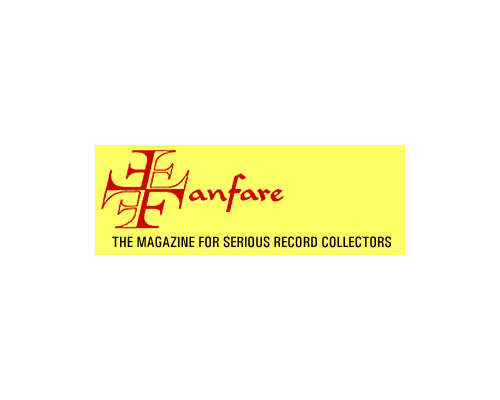Fanfare Magazine: “Between Breaths”

Published on March 1, 2024
by Colin Clarke | Share this post!
“So, we have five world premieres; five compositions by five composers birthed into the world of recorded music, in performances that surely could never be bettered. This disc receives an urgent recommendation.”
Previous releases have shown Third Coast Percussion to be an ensemble of the very highest echelon: Archetypes (in Fanfare 44:6) and Paddle to the Sea (41:6) are both executed to a superb standard. The present album’s title, Between Breaths, refers to music as a means of escape from the chaos of the modern world in which “designification” (the removal of meaning from signs) is omnipresent. With these
five works, the listener is invited to explore another space, one that offers a place from which perspective can once more make its mark.
Missy Mazzoli’s star is in the ascendent, certainly in the UK, where the Barbican Centre is according her one of its “Total Immersion” days: a whole day of events and performances from both BBC forces and students from the neighboring Guildhall School of Music and Drama. Her Millennium Canticles (2022),
commissioned by Third Coast Percussion and available for performance from the publishers Wise Music Classical after December 2024, glistens: Don’t listen to anyone who tells you that “all that glisters is not gold,” no matter what their literary stature. There is a whole world of sound here, performed with razor-sharp responses by Third Coast Percussion. The ethos of Enthusiasm Strategies (“I think of music itself … as a strategy for mustering enthusiasm and joy”), despite the piece’s premise, still seems to hold on some level.
The premise of Millennium Canticles is that the performers become a group of post-apocalyptic people who attempt to recreate stories and rituals of human life. The result is not all love and light: the darker shadows of the third movement, “Bloodied Bells,” are disturbing, certainly, as is the instability of “Choir of the Holy Locusts.” From frenzied counting to rhythmic breath sounds, all alongside perfectly calibrated and chosen percussion, the piece is notable for its exuberance, but with a darkly tinged underbelly. One has to wonder what the recording sessions were like, and how Third Coast Percussion’s combination of excitement and complete exactitude of execution was achieved.
Workshops are the basis for the collective compositions by Third Coast Percussion (TCP for short: the four performers are Sean Connors, Robert Dillon, Peter Martin, and David Skidmore). Here, the piece in question is called In Practice, and is based on the idea of ritual, including the ritual of our daily lives: So, found objects include coffee cups, cereal bowls, and electric toothbrushes. In the first movement (“Part”) the balancing act is between meditation and momentum, for the music is carried forward on a slow wave. The result is incredibly beautiful, especially as heard in Çedille’s superb recording. The second part of the work has far more movement and is nicely easy on the ear without insulting the intelligence. The music evaporates at the end, a slow, mutually-agreed fade.
The sound of Tyondai Braxton’s Sunny X is slightly, disconcertingly different. Some sounds could be electronic versions of jungle buzzings; others remain within the known. There is a decidedly Minimalist aspect here, not only in phasing but also in the clear juxtapositions of sections. Parts of the piece are explosions of energy that seem to have gone through some sort of a transformer. Braxton uses
such instruments as wooden and metal slats, steel pipes, Thai gongs, and crotales with a modular synthesizer for electronic playback. The piece sits well within the program as something of an interlude (or that is how it struck me). The title of Ayanna Woods’s Triple Point refers to a temperature at which a
substance may be simultaneously solid, liquid, and gas. In terms of observation,
the substance as a liquid bubbles into gas as rapidly as it freezes into a solid, for
example. The idea of musical objects “bubbling” to the surface and then disappearing (melting away?) is very much part of the piece’s trajectory. There are also definite moments of dynamic energy that might suddenly swerve into a more interior state. Independent of its formative idea, the piece stands perfectly well on its own two feet. Subversive rhythm seems to be part of the mix, too, rogue elements that attempt to derail the ongoing momentum. The whole is fascinating. This is Ayanna Woods’s first entry in the Fanfare Archive; may it not be her last. Finally, there comes Gemma Peacocke’s Death Wish. This is a tribute to Hinewirangi Kohu-Morgan, a Māori artist, poet, and activist, played on two marimbas by four players. There is a certain numbness here (one of the acknowledged responses as part of the bereavement process, along with, for example, anger and denial). The death wish of the title refers to Kohu-Morgan’s reaction to sexual abuse, in addition to a spiraling out of control of her life. Energy
in this piece comes and goes (or, spools and unspools, as the composer puts it), but there is a lens, that of viewing life from a slightly disassociated standpoint. So, we have five world premieres; five compositions by five composers birthed into the world of recorded music, in performances that surely could never be bettered. This disc receives an urgent recommendation.

